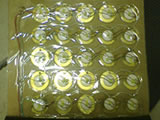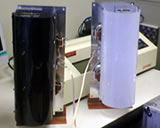Industry-Government-Academia Collaboration - A Case Study
Industrial Securities Project
This page offers a case study of various research activities and the results of industry-government-academia collaboration conducted at the Keio SFC Research Institute. (Position titles are those at the time of release.)
>> Archive of Industry-Government-Academia Collaboration - A Case Study
Industrial Securities Project
We would like to introduce Professor Yoshiyasu Takefuji of the Faculty of Environmental Information who specializes in industrial securities. At present he is working on various projects with East Japan Railways.
One of the collaborations with JR East Consultants Company started when Mr. Reiji Sugioka of ZCC KK (where Professor Takefuji also works as an advisor), and Mr. Hatsunori Hiroshige of the Japan Society of Civil Engineers, who are both Visiting Researchers of the Keio Research Institute at SFC, proposed the latest GPS to East-JR. The ZCC KK had originally developed the GPS in collaboration with the Trimble Company as a PVT model, which was based on the military technology developed by the United States (the same position, velocity, and UTC).
At an event jointly hosted by East-JR and JR East Consultants Company, Professor Takefuji became acquainted with Mr. Mutsutake Otsuka, the President of East-JR. At this event Professor Takefuji was introduced to Mr. Yasuo Mizobata, President of JR East Consultants Company. Both discussed plans to start a joint collaboration between Takefuji Laboratory and JR East Consultants Company. After this discussion Mr. Mitsuaki Kobayashi became a Visiting Researcher at the Keio Research Institute at SFC and the collaboration became a reality. The collaboration included not only hardware but also security software.
Apart from this there are various railway industry-related projects in progress, such as the one conducted by Mr. Koichiro Shoji from the Science Park Corporation who is also a Visiting Researcher at the Keio Research Institute at SFC.
Please find below details of some of the ongoing research projects at the Keio Research Institute at SFC:
 A propotype co-created by JR East Frontier Service Research Institute and the Keio Research Institute at SFC 1. Using human energy to operate escalators project
Essentially this project aims at using human energy to operate escalators and thereby create an environmentally friendly source of energy at train stations. Senior Visiting Researcher, Mr. Kiyoshi Eto collaborates on this project.
Source:
2. Wave speaker project
 A prototype of the Wave Speaker This project is developing a sound speaker system for the elderly and handicapped inside train cars and at railway stations, which is easy to use. Both Mr. Takuya Kato, a specialist in barrier-free PCs, and Mr. Hidetoshi Gotsu, originator of the Teragaki-style speaker system, are Senior Visiting Researchers collaborating on this project.
3. Network security project
This project aims to prevent the leakage of important data while using large-scale network systems. Mr. Koji, a Visiting Researcher, collaborates on this project. For details, please refer to the Science Park website (available in Japanese).
4. The GPS project
This project aims at detecting the exact location of a running train using the GPS system. Researchers have already tested the GPS using an actual JR express train namely the Azusa. Based on their findings the researchers have proposed to East-JR for installing a Train Location Service. Visiting Researchers Mr. Sugioka and Mr. Hiroshige are the main collaborators.
Source:
5. Other Projects
There are other ongoing projects, which aim to make IC tags and LPS that aim to new technology in the train industry.
(Release Date: 2006/01/26)
|




